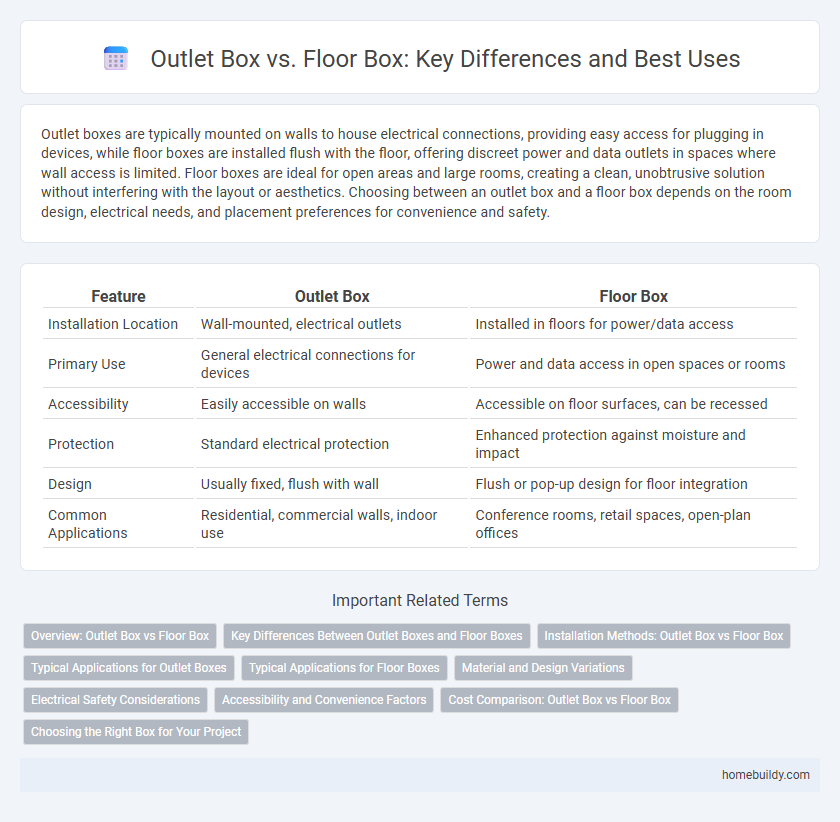Outlet boxes are typically mounted on walls to house electrical connections, providing easy access for plugging in devices, while floor boxes are installed flush with the floor, offering discreet power and data outlets in spaces where wall access is limited. Floor boxes are ideal for open areas and large rooms, creating a clean, unobtrusive solution without interfering with the layout or aesthetics. Choosing between an outlet box and a floor box depends on the room design, electrical needs, and placement preferences for convenience and safety.
Table of Comparison
| Feature | Outlet Box | Floor Box |
|---|---|---|
| Installation Location | Wall-mounted, electrical outlets | Installed in floors for power/data access |
| Primary Use | General electrical connections for devices | Power and data access in open spaces or rooms |
| Accessibility | Easily accessible on walls | Accessible on floor surfaces, can be recessed |
| Protection | Standard electrical protection | Enhanced protection against moisture and impact |
| Design | Usually fixed, flush with wall | Flush or pop-up design for floor integration |
| Common Applications | Residential, commercial walls, indoor use | Conference rooms, retail spaces, open-plan offices |
Overview: Outlet Box vs Floor Box
Outlet boxes are electrical enclosures typically mounted within walls to house wiring connections and receptacles, offering easy access for standard electrical outlets. Floor boxes are installed flush with the floor surface, designed to provide power and data connections in open spaces where wall access is limited or impractical. Both serve critical roles in electrical distribution but differ primarily in installation location and application, with floor boxes catering to versatile, accessible power solutions in commercial or residential floor areas.
Key Differences Between Outlet Boxes and Floor Boxes
Outlet boxes are typically wall-mounted enclosures designed to house electrical connections such as switches, outlets, and junction points, offering easy access and protection. Floor boxes are recessed units installed flush with the floor surface, providing electrical and data connections in open spaces while maintaining safety and preventing trip hazards. Key differences include installation location, accessibility, and intended use, with outlet boxes emphasizing wiring organization in walls and floor boxes focusing on flexible power and connectivity in floor areas.
Installation Methods: Outlet Box vs Floor Box
Outlet boxes are typically installed within walls and secured between studs using mounting brackets or nails, designed for vertical surfaces. Floor boxes require installation into cutouts within the floor, often requiring reinforcement and protection from foot traffic, making the process more complex due to subfloor access and alignment. Proper installation methods for floor boxes also include ensuring waterproofing and compliance with electrical codes for safety in horizontal applications.
Typical Applications for Outlet Boxes
Outlet boxes are commonly used in residential and commercial wall installations for housing electrical connections safely and securely. They provide a standardized enclosure for switches, receptacles, and other devices, facilitating easy access for maintenance and upgrades. Typical applications include wall-mounted outlets, light switch boxes, and junction points within walls for wiring distribution.
Typical Applications for Floor Boxes
Floor boxes are commonly installed in commercial office spaces, conference rooms, and open floor plans to provide convenient access to power, data, and communication outlets without disrupting the layout. These boxes are ideal for areas where wall outlets are insufficient or inaccessible, allowing flexible workstation arrangements and reducing exposed wiring. Perfect for environments requiring frequent reconfiguration, floor boxes support collaboration and technology integration seamlessly.
Material and Design Variations
Outlet boxes commonly feature durable plastic or metal materials designed for wall mounting, offering various sizes to accommodate different electrical devices. Floor boxes prioritize robust, corrosion-resistant metals like stainless steel or brass, with sealed designs to protect against moisture and heavy foot traffic. Both types present diverse configurations, but floor boxes emphasize low-profile, flush installation for safety and aesthetics in high-traffic areas.
Electrical Safety Considerations
Outlet boxes and floor boxes differ significantly in electrical safety considerations due to their installation environments. Outlet boxes are typically mounted on walls, providing a protective enclosure that reduces the risk of electrical shocks and fire hazards by securely housing wiring connections. Floor boxes require robust sealing and moisture resistance features to prevent electrical hazards associated with foot traffic, spills, and cleaning processes while maintaining compliance with grounding and circuit protection standards.
Accessibility and Convenience Factors
Outlet boxes offer easier accessibility for wall-mounted electrical connections, allowing quick access for maintenance and device plugging without bending or moving furniture. Floor boxes provide convenience in open spaces by delivering power and data ports where wall outlets are impractical, though they require floor-level access which may be less ergonomic. Choosing between outlet boxes and floor boxes depends on the specific use case, balancing accessibility needs with spatial design and convenience.
Cost Comparison: Outlet Box vs Floor Box
Outlet boxes generally cost less than floor boxes due to simpler installation and fewer materials required. Floor boxes often involve higher expenses because they must be durable enough to withstand foot traffic and may require specialized installation in concrete or raised floors. Budget-conscious projects typically favor outlet boxes for cost savings, while floor boxes offer added functionality at a premium price.
Choosing the Right Box for Your Project
Selecting the right box for your wiring project depends on location and functionality, with outlet boxes typically mounted on walls to house electrical outlets and switches securely. Floor boxes offer a discreet solution for power and data access in open spaces, providing flush installation within the floor surface that accommodates heavy foot traffic. Consider the specific electrical requirements, environmental conditions, and aesthetic preferences to determine whether an outlet box or floor box best suits your project's needs.
Outlet box vs Floor box Infographic

 homebuildy.com
homebuildy.com